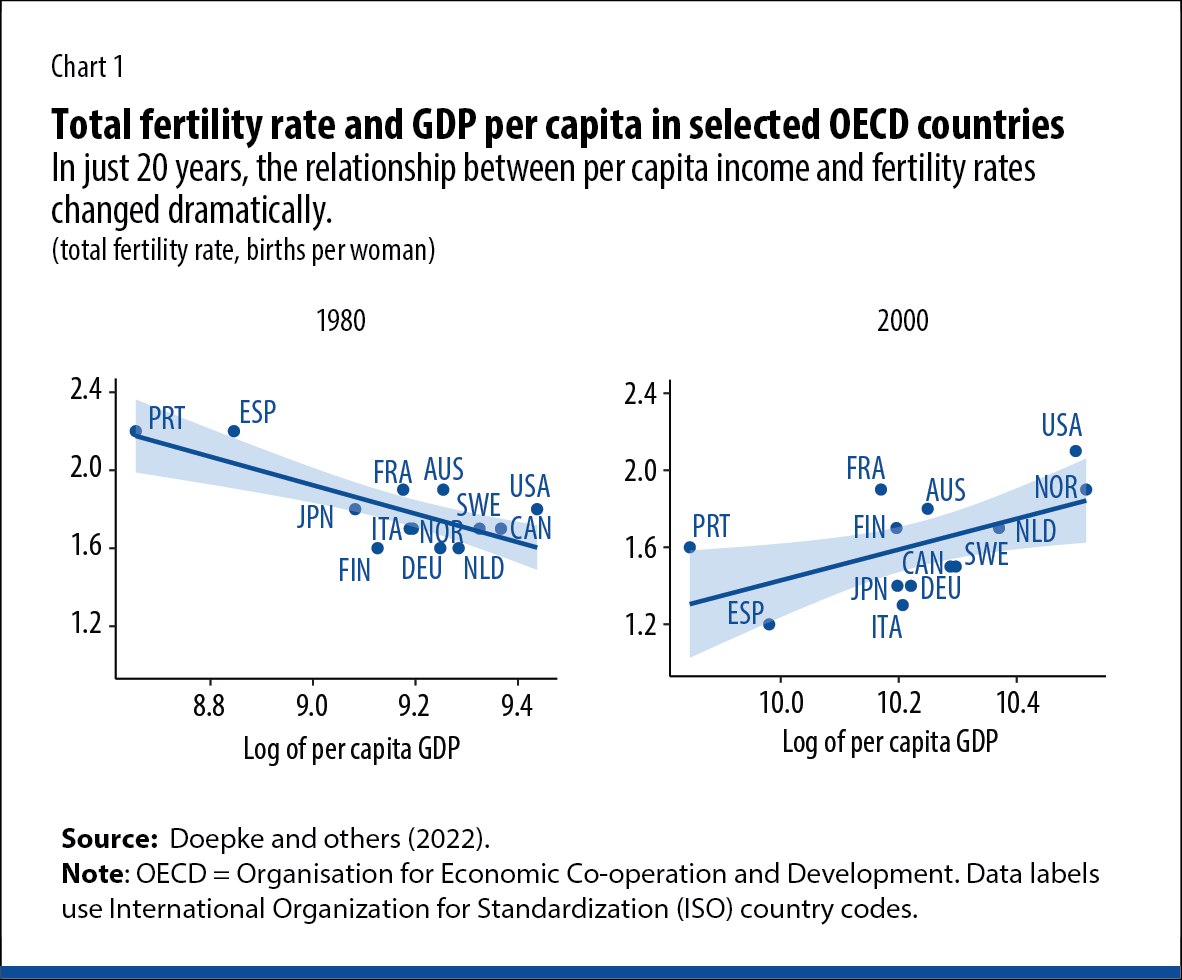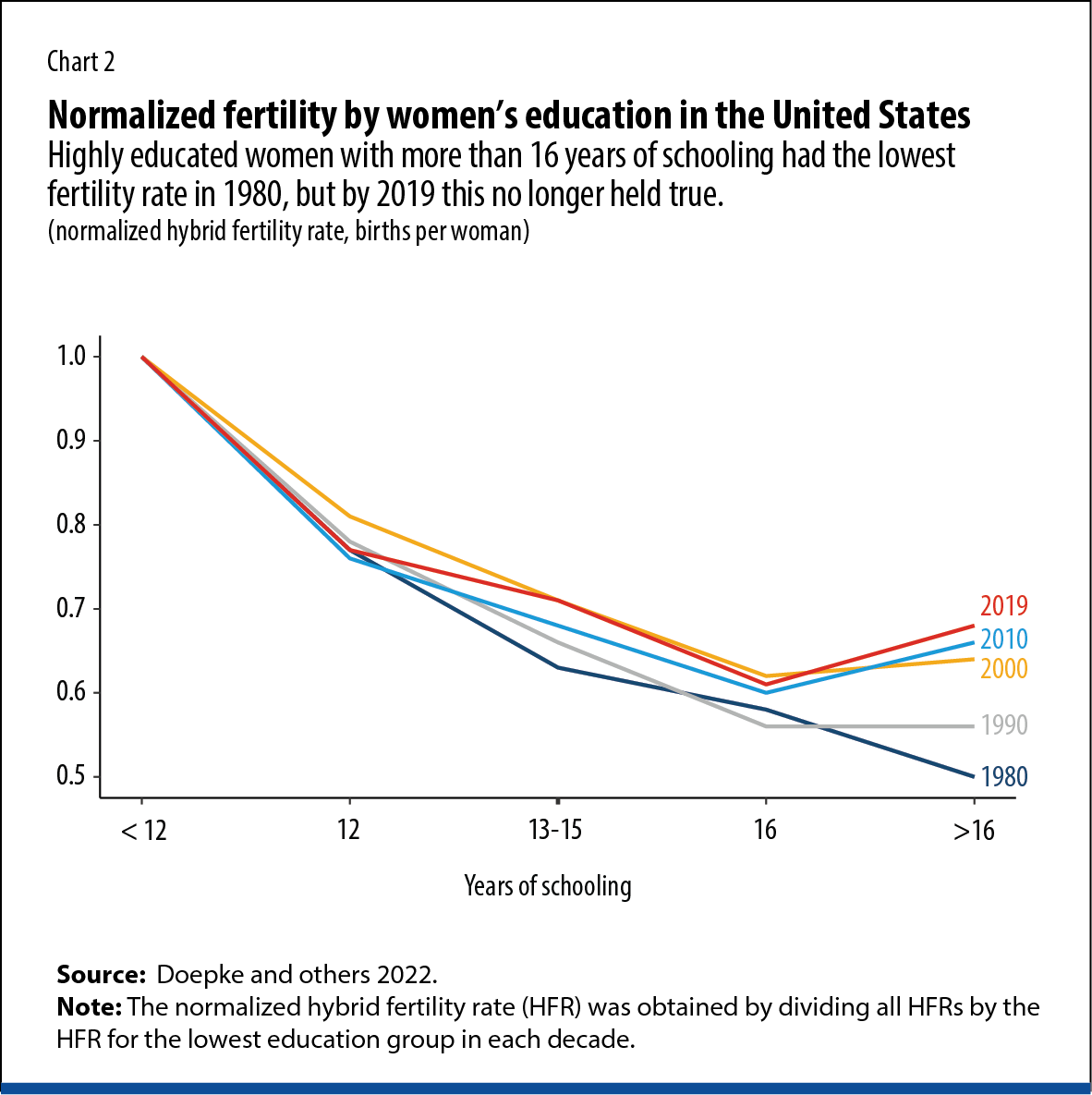July 22, 2022
People and economies will prosper if policymakers help women combine career and family
Fertility in high-income countries has been declining for a hundred years, with few exceptions, and in many areas, it is now extraordinarily low. In Germany, Italy, Japan, and Spain fertility has been well below 1.5 for more than two decades—lower than the average of just over two children per woman needed to maintain a stable population size. This means that each new generation is less than three-quarters the size of the preceding one. Such ultralow fertility makes for a rapidly rising older population and poses challenges for governments, economies, and the sustainability of social security systems.
Substantial economic research on individual fertility decisions has naturally focused on the pervasive trends associated with this demographic transition—primarily negative relationships between fertility and income and between female labor force participation and income. Economists have proposed two main explanations.
The first is known as the quantity-quality trade-off. It suggests that as parents get richer, they invest more in the “quality” (for example, education) of their children. This investment is costly, so parents choose to have fewer children as incomes rise. Historically fertility and GDP per capita are strongly negatively related, both across countries and over time.
The second explanation acknowledges how time-consuming it is to raise children. As wages increase, devoting time to childcare—time that could otherwise be spent working—becomes more costly for parents, and especially for mothers. The result is a decline in fertility and greater female labor force participation. There is in fact historically a strong negative association between female labor force participation and fertility over time and across countries.
New fertility facts
The data show that these relationships are no longer universally true. Despite a continued negative income-fertility relationship in low-income countries (in particular in sub-Saharan Africa), it has largely disappeared both within and across high-income countries. The same is true for the relationship between fertility and female labor force participation. In a recent survey (Doepke and others 2022) and a VoxEU column (June 11, 2022), we outline these new empirical regularities and discuss the key factors that explain fertility outcomes in recent decades.
For a long time, high per capita income in a country reliably indicated low fertility. In 1980, fertility was still well above two children per woman in poorer countries, such as Portugal and Spain, but just 20 years later, fertility in the same set of countries had changed substantially (Chart 1). In fact, in 2000 the United States, the second-richest country in the sample, exhibited the highest fertility rate.
The fertility pattern across families in high-income countries (such as France, Germany, and the United States) has changed as well. Historically, the relationship between female education and fertility is clearly negative, consistent with higher wages increasing the opportunity cost of raising children. Yet this negative relationship is weaker for US women of recent birth cohorts (Chart 2). Although highly educated women with more than 16 years of schooling had the lowest fertility rate in 1980, this no longer held true in 2019 (see also Hazan and Zoabi 2015).
Career-family compatibility
The recent empirical regularities point to fertility behavior in high-income countries today that is driven by factors not immediately captured by the quantity-quality trade-off nor the opportunity cost of time. Researchers across disciplines had to contemplate alternative mechanisms responsible for within- and across-country fertility patterns in high-income countries (see Rindfuss and Brewster 1996 and Ahn and Mira 2002 for early contributions). A common theme has emerged from this broad scholarly discussion: the compatibility of women’s careers and families.
There has been a fundamental economic transformation: in many high-income countries women now participate in the labor force for much of their lives. The earlier pattern of a woman entering the labor market but dropping out following marriage and children is now the exception rather than the norm. Most women today want the option of both a fulfilling career and a family. From a historical perspective, we can interpret this shift as a convergence of women’s and men’s overall life plans after a long period of sharply divided gender roles.
While the shift in women’s career plans is shared across high-income countries, there is still substantial variation in how compatible women’s careers and families really are. Four factors explain the variation in career-family compatibility across countries: family policies, cooperative fathers, favorable social norms, and flexible labor markets.
A key determinant of career-family compatibility is women’s access to affordable alternatives to the time devoted to caring for children, time historically provided exclusively by mothers. In some countries, such as the United States, these alternatives are largely organized in private markets, while many European countries offer publicly provided childcare. Cheap and easily available childcare frees up women’s time and allows them to combine motherhood with a career, which ultimately increases fertility. In countries such as Sweden and Denmark, where public childcare is widely available for children of all ages, female employment and fertility rates today are higher than in countries where childcare is sparse. Not surprisingly, these countries also spend a larger fraction of their GDP on public early childhood education. Other policies that influence career-family compatibility include parental leave policies, tax policies, and the length of the school day.
Fathers can of course care for children as well. Although historically fathers have spent little time caring for children, the data show an increase in recent decades. The division of childcare between parents has important implications for fertility when parents contemplate the decision to have children. Doepke and Kindermann (2019) show that in countries where fathers engage more in childcare and housework, fertility is higher than where such labor falls disproportionately on women. Japan, where men share little in caring for children, bears this out: fertility there continues to be ultralow.
A third influence on modern fertility decisions is social norms regarding a mother’s role at home and in the workplace. Low fertility can be a result of traditional social norms. For example, the characterization of a full-time working mother as a Rabenmutter (bad mother) is still common in Germany and imposes an implicit penalty on mothers who aspire to both family and career.
Finally, labor market conditions also affect career-family compatibility. In Spain, for example, a country with a two-tier labor market where jobs are either temporary or for a lifetime, women tend to postpone childbearing in hopes of landing a stable job first. Such labor market conditions naturally dampen fertility. More generally, when unemployment is high, temporary jobs are common and permanent jobs are hard to obtain—even taking temporary leave to start a family can have long-term repercussions for women’s labor market prospects. Fertility rates may consequently be lower than in a setting where secure, long-term jobs are easy to find.
Policy implications
For policymakers concerned about ultralow fertility, the new economics of fertility does not offer easy, immediate solutions. Factors such as social norms and overall labor market conditions change only slowly over time, and even potentially productive policy interventions are likely to yield only gradual effects. Yet the clear cross-country association of fertility rates with measures of family-career compatibility shows that ultralow fertility and the corresponding fiscal burden are not inescapable, but a reflection of a society’s policies, institutions, and norms. Policymakers should take note and take a career-family perspective. Investing in gender equality—and especially the labor market prospects of potential mothers—may be cumbersome in the short run, but the medium- and long-term benefits will be sizable, for both the economy and society.
Opinions expressed in articles and other materials are those of the authors; they do not necessarily reflect IMF policy.
References:
Ahn, Namkee, and Pedro Mira. 2002. “A Note on the Changing Relationship between Fertility
and Female Employment Rates in Developed Countries.” Journal of Population Economics 15 (4): 667–82.
Doepke, Matthias, Anne Hannusch, Fabian Kindermann, and Michèle Tertilt. 2022. “The Economics of Fertility: A New Era.” CEPR Discussion Paper 17212, Centre for Economic Policy Research, London.
Doepke, Matthias, and Fabian Kindermann. 2019. “Bargaining over Babies: Theory, Evidence, and Policy Implications.” American Economic Review 109 (9): 3264–306.
Hazan, Moshe, and Hosny Zoabi. 2015. “Do Highly Educated Women Choose Smaller Families?”
Economic Journal 125 (587): 1191–226.
Rindfuss, Ronald R., and Karin L. Brewster. 1996. “Childrearing and Fertility.” Population and
Development Review 22:258–89.














